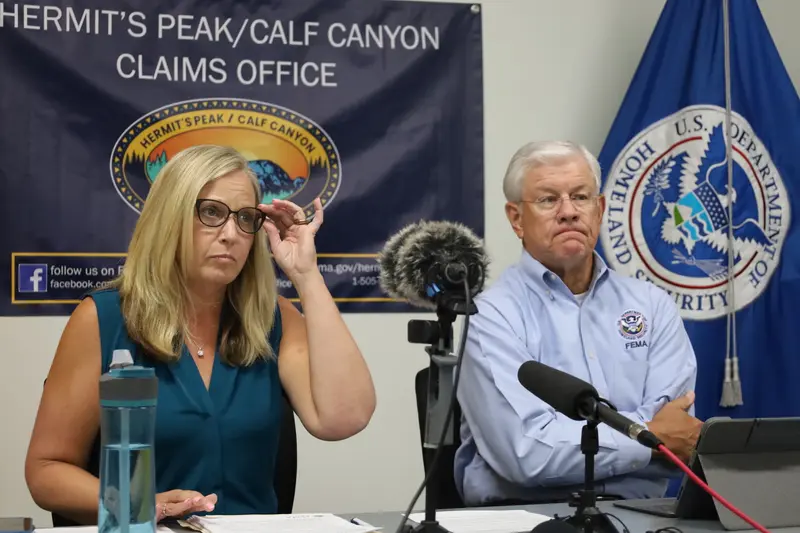This article was produced for ProPublica’s Local Reporting Network in partnership with Source New Mexico. Sign up for Dispatches to get stories like this one as soon as they are published.
FEMA Has So Far Paid Out Less Than 1% of What Congress Allocated for Victims of New Mexico Wildfire
Congress gave FEMA $3.95 billion to compensate victims of the Hermits Peak-Calf Canyon Fire in northern New Mexico. Seven months later, just $3 million has been paid, and most hasn’t gone to households.


Series: The Long Burn
The Slow Recovery From New Mexico’s Largest Wildfire
A couple months after two planned fires escaped to become the largest wildfire in New Mexico history, President Joe Biden promised to “fully compensate survivors.” Late last year, Congress allocated $3.95 billion to do so.
Seven months later, the Federal Emergency Management Agency has paid only about $3 million in claims.
Most of that went to the city of Las Vegas, New Mexico, which narrowly escaped the blaze but suffered damage to its water system. The rest — a total of $400,000 at most — has gone to individuals, an agency official acknowledged last week. The blaze burned hundreds of homes and over 530 square miles of land.
The pace of payments has frustrated fire victims and members of New Mexico’s congressional delegation, who in May urged FEMA to move more quickly. U.S. Rep. Teresa Leger Fernández, a Democrat from Las Vegas, said in a written statement on Thursday that her office will keep up the pressure.
“We know how painful and hard this process has been for those who lost so much,” Leger Fernández said. “We will continue to push to get payments out as fast and efficiently as possible.”
The Hermits Peak-Calf Canyon Fire grew out of two prescribed burns ignited by the United States Forest Service. In April 2022, fueled by high winds in a drought-stricken forest, they merged. Over the next few months, the fire rolled through Mora and San Miguel counties in northern New Mexico.
The Forest Service took responsibility for the blaze, and Congress tasked FEMA with paying victims through a new claims office.
At a news conference on Thursday, Angela Gladwell, director of that office, said that beyond the $3 million in claims that have been paid, several million dollars more are close to being paid out.
Even still, that would be a fraction of 1% of the money allocated by Congress.
There’s widespread agreement about the need to repair the Las Vegas water system, which was damaged when water laden with sediment and contaminants flowed into the treatment plant during heavy rains that followed the fire.

At one point last summer, while the Gallinas River was contaminated, the city had in reserve just 21 days of clean drinking water for residents. When its reservoirs are full, the city has 200 days of water.
Las Vegas Mayor Louie Trujillo said the $2.6 million is the first installment toward what will ultimately be a $140 million project.
But he said he’s far more concerned about people dealing with the “slow and agonizing” process of being compensated by FEMA for losses to their homes, properties and livelihoods.
The $400,000 that has gone to individuals is surprisingly little, he said: “I don’t want to sound ungrateful, but my concern is not as much how efficient they’ve been for the city government, as they are about individuals who had losses.”
Gladwell said the claims office has received more than 1,500 notices of loss from more than 2,500 people, businesses, governments and other claimants since November. A notice of loss signals that a victim intends to make a claim for damages.
The office has formally acknowledged 850 of those notices, she said, which starts a 180-day clock to decide how much FEMA will pay.
Meanwhile, FEMA is winding down its emergency response, which came in the form of disaster assistance payments and, in some cases, temporary housing offered in the weeks and months after the fire.
FEMA offered housing to some people who had lost their primary residences, saying it would try to put trailers or mobile homes on their land. But in late April, Source New Mexico and ProPublica found that just two households had gotten housing on their land. Eleven others received housing at commercial parks that in some cases were miles away.
The rest of those eligible — people whose uninsured primary residences were destroyed or badly damaged — found other housing options, which in some cases was a friend or relative’s couch or substandard housing during a grueling winter.
The agency marked them as having found “another housing resource,” according to a FEMA spokesperson.
Since then, another couple has gotten housing on their land and another person got housing at a commercial park.
FEMA noted that terrain and weather, among other factors, made it hard to provide housing. It said it couldn’t place trailers on people’s land in many cases because of federal laws and its own requirement that trailers be hooked up to utilities.
Lawmakers who signed the legislation compensating victims for the federal government’s mistakes have said they wanted individuals and families to be paid first, and businesses, nonprofits and governments later.
At public meetings, FEMA officials have defended their rollout of the claims office. Creating a compensation program is a major undertaking for a federal bureaucracy, and this is the fastest FEMA has ever established an office, the agency said in May. The agency had to work quickly to create policies, open three field offices and staff up. About a dozen navigators, all locals, have been hired to guide victims through the process.
This is the second time FEMA has been in charge of compensating wildfire victims. The first one was also in New Mexico, when the National Park Service ignited a blaze that escaped and burned homes in Los Alamos in 2000.
Six months after legislation was passed to compensate victims of that fire, known as the Cerro Grande Fire, FEMA had paid about $20.5 million to individuals and businesses — about 4% of the $545 million eventually paid out. That $20.5 million included more than $10 million to 1,625 individuals, according to a news release at the time.
FEMA has not yet finalized its rules governing what types of losses and expenses will be covered for the Hermits Peak-Calf Canyon Fire. Gladwell has said those rules must be approved by higher-ups at FEMA, the Department of Homeland Security and the White House Office of Management and Budget.
She said Thursday she doesn’t know when the rules might be approved.
Even without final rules, FEMA officials stress that claimants can receive partial payments now for some losses.
“The claims process is operational today and ready to support New Mexicans who suffered losses by these fires immediately,” FEMA spokesperson Michael Hart said.
The office has announced it’s working with an office in the Department of Agriculture to help people calculate their losses. And it will now pay victims’ flood insurance premiums for up to five years.
Nov. 14, 2024, is the deadline for people to submit notice of loss forms to the claims office.
Were You Affected by the Massive Wildfire in Northern New Mexico? We Want to Hear From You.
Last summer’s wildfire caused thousands to flee. Source New Mexico and ProPublica want to know if people got the help they needed.
This article was produced for ProPublica’s Local Reporting Network in partnership with Source New Mexico. Sign up for Dispatches to get stories like this one as soon as they are published.
This article was produced for ProPublica’s Local Reporting Network in partnership with Source New Mexico. Sign up for Dispatches to get stories like this one as soon as they are published.






